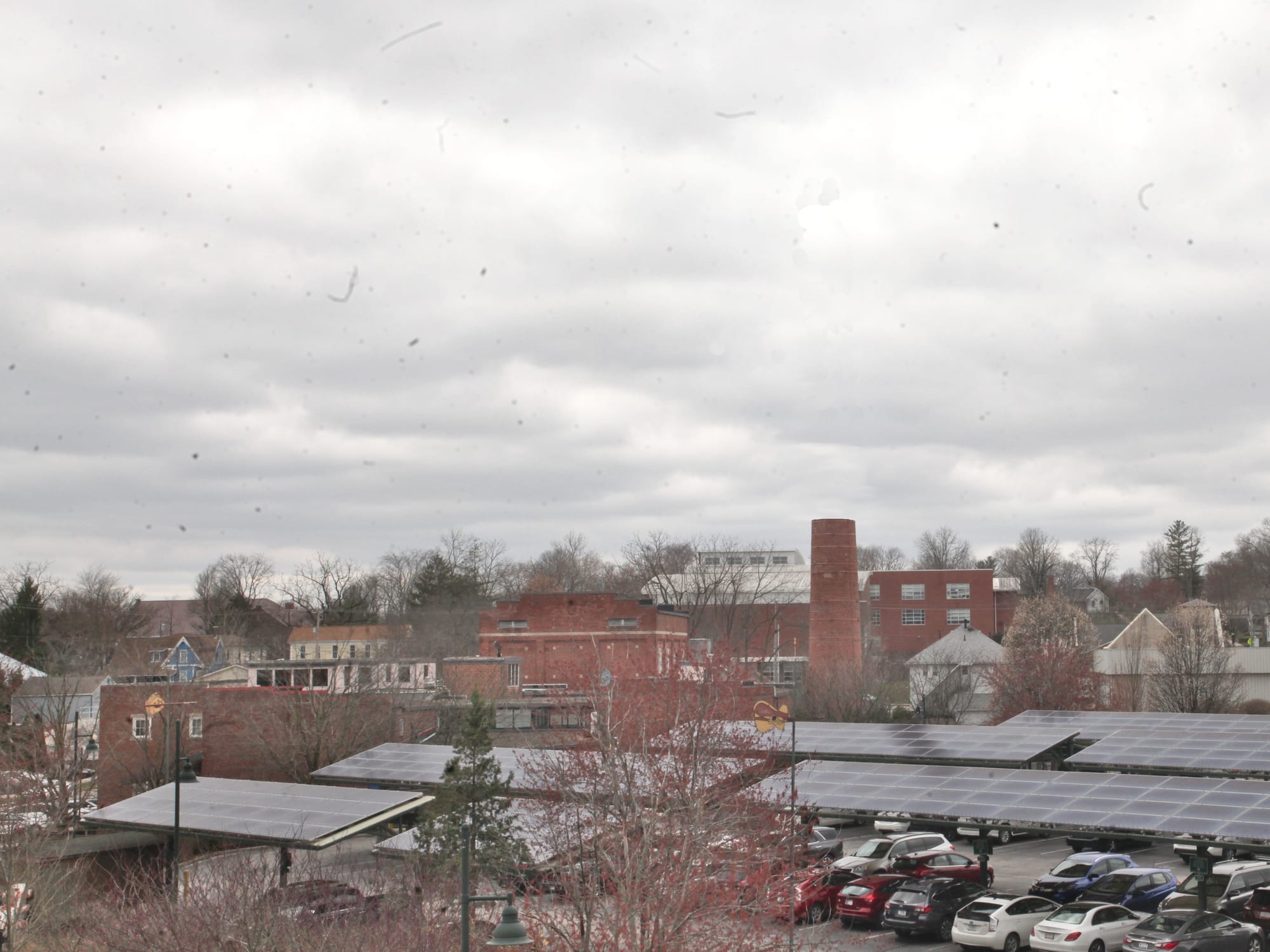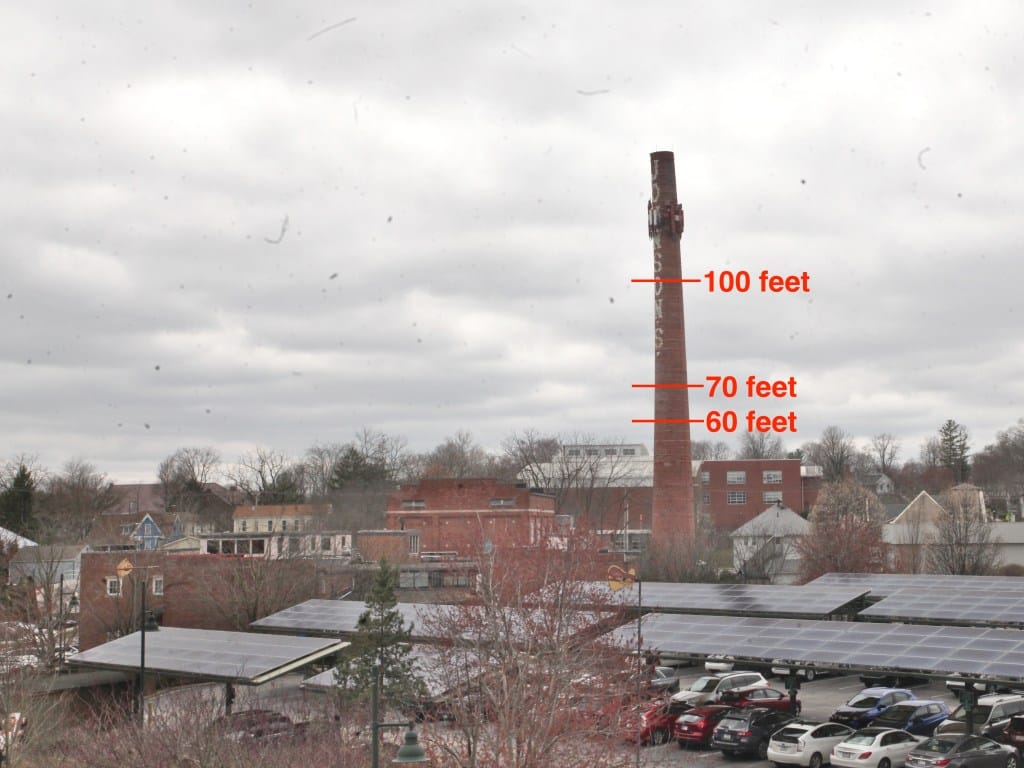HPC says Johnson’s smokestack OK to be chopped to 60 feet, Bloomington city council next to weigh in



On Thursday, Bloomington’s historic preservation commission (HPC) voted to approve a certificate of appropriateness (COA) for the demolition of the Johnson’s Creamery smokestack down to 60 feet.
No conditions are attached to the COA. The commission weighed the idea of requiring the owner to propose a way to commemorate the history of the building through an artwork. But in the end that was not a part of the COA.
Thursday’s vote put back on the books the action taken by HPC last week, but which it rescinded at the same meeting, amid confusion about the substance of the vote.
The city’s housing and neighborhood development (HAND) department has issued an order to the owner, Peerless Development, to demolish the smokestack down to 60 feet, based on a report recently completed by Arsee Engineers.
The engineering report concluded that the structure cannot be restored at its full height and still meet modern building codes. Any masonry smokestack would be susceptible to wind and seismic loads that would preclude restoration at that height, the report said.
Thursday’s action is meant to preserve as much of the 140-foot smokestack as possible.
Also playing a role in the possible protection of the smokestack is Bloomington’s city council. It will be up to the council to enact the historic district that the HPC has recommended. On Wednesday, the council discussed the historic district designation for the building at its committee-of-the-whole meeting. The council’s decision on the district, including the boundaries, is set for next Wednesday, April 6.
At Wednesday’s committee-of-the-whole council meeting, Duncan Campbell, who serves as an advisory member of the HPC, addressed the six city councilmembers who attended. Campbell led the restoration of the Johnson’s Creamery building in the 1990s, and described the historic significance of the building and the smokestack.
Campbell said, “As we respect development rights and the desire to move on and to have progress, we can still acknowledge our community. And we can still stand up for the things that our forebears did and did right, actually.”

He continued: “It’s nobody’s fault that we don’t need creameries anymore. Kroger has taken care of that for us. But we did need them—and a huge part of the community.”
He added, “That wonderful picture of horse-drawn carriages alongside motorized vehicles. That’s who delivered the milk here for 75 years, OK?” He wrapped up: “Let’s don’t forget that. And let’s don’t forget this building, and let’s don’t forget what we’re trying to do tonight.”
The HPC’s action on Wednesday was a bit of a cart-before-the-horse situation. Normally, a historic district would be enacted by the city council before a COA would be considered and approved. The COA that was approved on Wednesday is contingent on the council’s enactment of a historic district.
Councilmember Jim Sims expressed some dissatisfaction with the sequencing of the work. Sims said, “One of the things I…don’t really appreciate, is that the council is trying to do some things while other bodies are trying to do some things.” He added, “As long as I sit on this council, I really appreciate that all those other agencies or entities get their work done before it comes to us.”
The city council’s committee voted 6–0 to recommend approval of the historic district, with boundaries as defined by the HPC. (Absent were Steve Volan, Matt Flaherty, and Kate Rosenbarger.) The approved district boundaries follow the parcel boundary, but slice it in half, leaving the southern part of the parcel as the district. The owner, Peerless Development, has approved plans for a housing development on the northern half of the property.
Peerless would prefer that the boundaries hug the contour of the building foundation.
An amendment to the historic district boundaries that was floated at Wednesday’s committee meeting by councilmember Isabel Piedmont-Smith would have gone a step further. Piedmont-Smith’s amendment to the boundary would have excluded the smokestack from the historic district.
Piedmont-Smith’s amendment got just two votes of support among the councilmembers present at the committee meeting—from Piedmont-Smith and Sims. Those votes are not binding—councilmembers can vote as they like at their regular meeting, no matter how they voted at the committee meeting.
About her amendment, Piedmont-Smith wanted to establish that Peerless had not asked her to propose it. She said, “I’d like to make it clear that I did not talk to Mr. [Michael] Cordaro [Peerless Development founder], or anyone from Peerless Development—this amendment is proposed by myself and of my own accord.”
Piedmont-Smith said about the reduction in height to 60 feet: “I feel like that does not really allow for preservation of the historic record. And since we cannot—due to engineering and building standards—maintain this smokestack at its original height, and it has to be reduced by more than half, I don’t see any point in keeping it.”
The 2–4 vote at the committee meeting on the exclusion of the smokestack from the historic district, drew the attention of former city councilmember Chris Sturbaum, who sits on the HPC as an advisory member. That’s because the tally is not decisive.
If the three members who were absent at the committee meeting were to support the amendment next Wednesday, that would give it the five votes it needs to pass.
That scenario was likely the one that former city councilmember Chris Sturbaum had in mind when he told his colleagues on the HPC on Thursday that “This is much closer politically than we realize.”
Sturbaum serves as an advisory member to the HPC. Sturbaum raised the specter of the smokestack’s potential exclusion from the district in the context of the HPC deliberations on the question of attaching a condition to the COA. The condition would have required Peerless to propose a way to commemorate the remaining 60 feet of smokestack with some kind of art installation.
Sturbaum urged the voting members of the HPC to approve the COA for demolition down to 60 feet without any requirement for a proposed commemorative artwork. “If we come out to the council with an unclear resolution here, we could lose the boundaries, and we could possibly lose the smokestack,” he said. Sturbaum added, “And I think that is the political reality. I’ve talked to a council member who affirmed that very reality for us.”
Whether the HPC has the legal authority to impose a condition on the COA is disputed.
At last week’s HPC meeting, Christine Bartlett, the attorney for Peerless Development, laid out an analysis of the city code and state statute in support of the idea that the HPC has no such power. Assistant city attorney Daniel Dixon said the city disagrees with Bartlett’s position, but did not lay out arguments.
At Thursday’s meeting, HPC member Reynard Cross wrestled with the question of attaching a condition, given the legal dispute. If the HPC has the legal right to impose such a condition, he felt the HPC should assert that right, on pain of losing that right in the future. In the end, he voted for the COA without the condition.
The city council’s meeting on Wednesday April 6 next week starts at the usual 6:30 p.m. time in council chambers with a Zoom link available.
Photos: Bloomington HPC meeting March 31, 2022
Click to view slideshow.




Comments ()